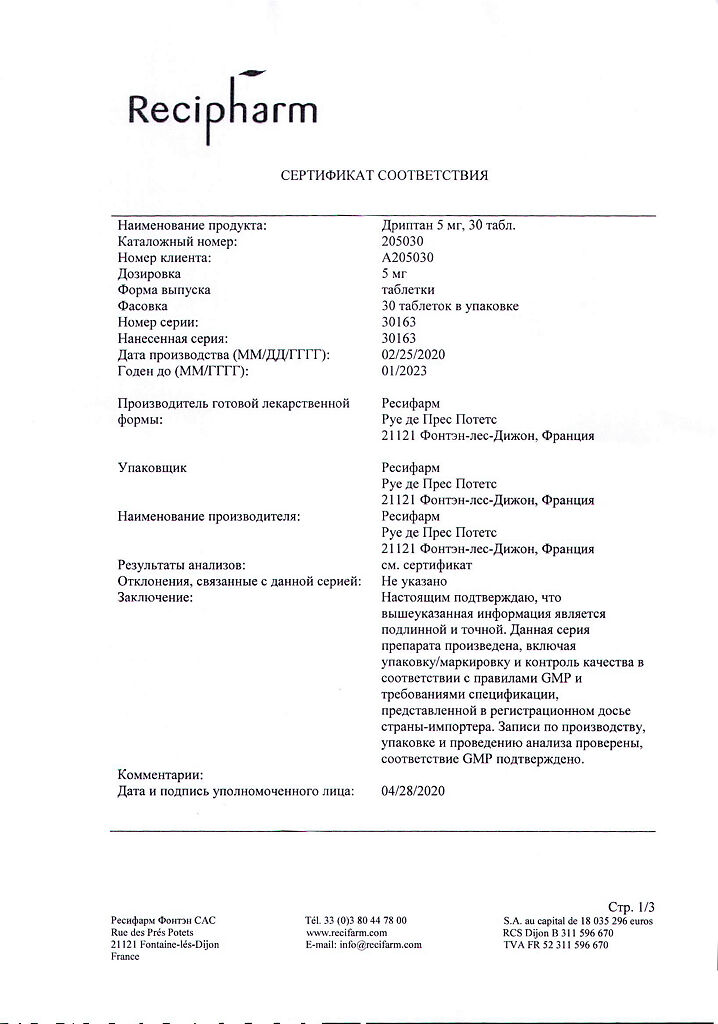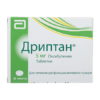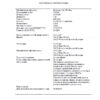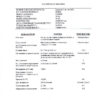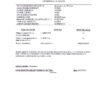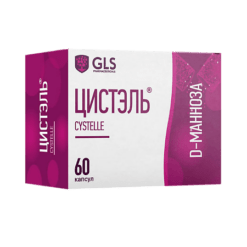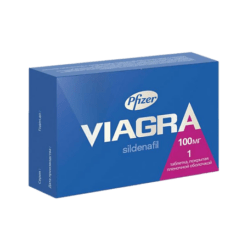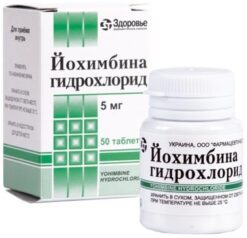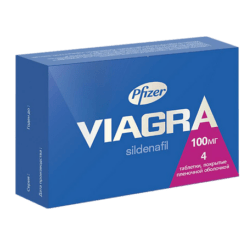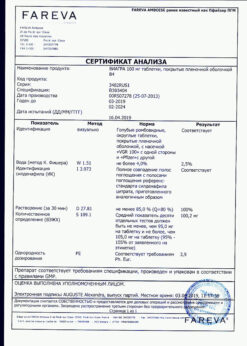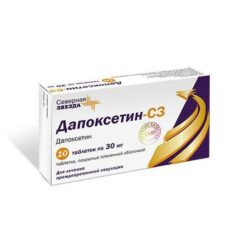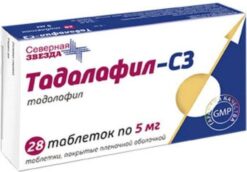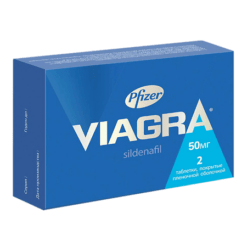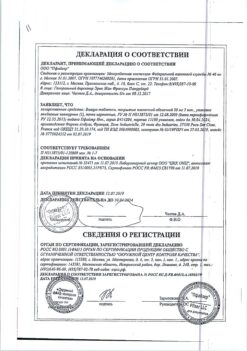No products in the cart.
Driptan, tablets 5 mg, 30 pcs.
€1.00
Out of stock
(E-mail when Stock is available)
Description
Pharmacotherapeutic group: spasmolytic agent.
ATC: G04BD04
Pharmacological properties
Pharmacodynamics
Oxybutynin has an antispasmodic effect on detrusor smooth muscle fibers and an anticholinergic effect by blocking the action of acetylcholine on the m-cholinoreceptors of smooth muscles. These properties contribute to relaxation of the bladder detrusor. In patients with unstable bladder function, the drug increases bladder volume and decreases the frequency of spontaneous detrusor contractions.
Pharmacokinetics
. When administered orally, oxybutynin is rapidly absorbed in the gastrointestinal tract – maximum plasma concentration (Cmax) is reached in less than 1 hour and then decreases biphasically with a half-life of 2-3 hours. The maximum effect is observed within 3-4 hours, the residual effect may persist for more than 10 hours.
Equilibrium concentration is reached after 8 days of oral administration. In elderly patients with an active lifestyle, oxybutynin does not appear to accumulate and its pharmacokinetics does not differ from that of other adult patients. However, Cmax and AUC (area under the concentration-time curve) values are significantly increased in impaired elderly patients. Oxybutynin is extensively metabolized in the liver, primarily by cytochrome P450 system enzymes, in particular CYP3A4, which is found mainly in the liver and intestinal walls; metabolites also have M-cholin-blocking effects. The main route of excretion is through the kidneys. Only 0.3-0.4% of the unchanged drug is detected in the urine of rats after 24 h and 1% in the urine of dogs after 48 h. Consequently, in rats and dogs oxybutynin is almost completely metabolized
Indications
Indications
Adults
– urinary incontinence, urinary urgency and frequency of urination associated with instability of bladder function, resulting either from neurogenic disorders (detrusor hyperreflexia) in diseases such as multiple sclerosis and spina bifida, or due to idiopathic disorders of detrusor function (motor urgency urinary incontinence).
– overactive bladder that occurs after surgery on the bladder or prostate gland, or with concomitant cystitis.
Children over 5 years old
– urinary incontinence, urinary urgency and frequency of urination associated with instability of bladder function, resulting either from idiopathic overactive bladder or neurogenic bladder dysfunction (detrusor overactivity);
– nocturnal enuresis associated with detrusor overactivity, in combination with non-drug methods when other therapy is ineffective.
Pharmacological effect
Pharmacological effect
Pharmacotherapeutic group: antispasmodic.
ATX: G04BD04
Pharmacological properties
Pharmacodynamics
Oxybutynin has an antispasmodic effect on detrusor smooth muscle fibers, as well as an anticholinergic effect by blocking the effect of acetylcholine on smooth muscle m-cholinergic receptors. These properties help relax the bladder detrusor. In patients with unstable bladder function, the drug increases bladder volume and reduces the frequency of spontaneous detrusor contractions.
Pharmacokinetics
When taken orally, oxybutynin is rapidly absorbed from the gastrointestinal tract – the maximum concentration (Cmax) in plasma is reached in less than 1 hour, and then decreases biphasically with a half-life of 2-3 hours. The maximum effect is observed within 3-4 hours, the residual effect can last more than 10 hours.
Equilibrium concentration is achieved after 8 days of oral administration of the drug. In elderly patients leading an active lifestyle, oxybutynin does not appear to accumulate, and its pharmacokinetics do not differ from those in other adult patients. However, in frail elderly patients, Cmax and AUC values (area under the concentration-time curve) increase significantly. Okibutynin is extensively metabolized in the liver, primarily with the help of enzymes of the cytochrome P450 system, in particular CYP3A4, which is found mainly in the liver and intestinal walls; metabolites also have an M-anticholinergic effect. The main route of excretion is through the kidneys. Only 0.3-0.4% of the unchanged drug is detected in the urine of rats after 24 hours and 1% in the urine of dogs after 48 hours. Consequently, in rats and dogs, oxybutynin is almost completely metabolized
Special instructions
Special instructions
Impact on the ability to drive a car and other mechanisms
This medicine may cause drowsiness or blurred vision. Patients should refrain from driving a car or using other machinery unless their physical and mental abilities have changed.
Active ingredient
Active ingredient
Oxybutynin
Composition
Composition
1 tablet contains:
Active ingredient: oxybutynin hydrochloride – 5.00 mg.
Excipients: microcrystalline cellulose – 17.80 mg; anhydrous lactose – 153.30 mg; calcium stearate – 1.90 mg.
Pregnancy
Pregnancy
Pregnancy
The safety of oxybutynin during pregnancy has not been established. An animal study showed that the use of the drug in doses that have a toxic effect on the mother’s body causes reproductive toxicity. Available animal studies are insufficient to assess the effect of the drug on pregnancy, embryonic development, childbirth or postnatal development.
The drug should not be used in pregnant women, unless the expected benefit to the mother from its use outweighs the potential risk to the fetus.
Breastfeeding period
Animal studies have shown that oxybutynin is found in breast milk. Accordingly, the drug should not be used during breastfeeding.
Contraindications
Contraindications
– hypersensitivity to the active substance or to any of the excipients;
– myasthenia gravis;
– angle-closure glaucoma or small anterior chamber of the eye;
– patients with hyperthermia or in conditions of high ambient temperature due to the risk of developing heat stroke;
– children under 5 years of age due to insufficient data on effectiveness and safety;
– dysfunction of the esophagus, including hiatal hernia;
– functional or organic obstruction of the gastrointestinal tract (GIT), including pyloric stenosis, paralytic ileus, intestinal atony;
– presence of ileostomy, colostomy, toxic dilatation of the colon (megacolon), severe ulcerative colitis;
– bladder outlet obstruction, in which urinary retention can be caused, among other things. prostatic hypertrophy;
– period of breastfeeding.
Due to the fact that the drug contains lactose, Driptan® is contraindicated in cases of congenital galactosemia, glucose-galactose malabsorption, lactase deficiency, galactose intolerance.
With caution
– elderly people due to the fact that they may be more sensitive to the effect of the drug (dose reduction may be required, see section “Method of administration and dosage”);
– pathology of the autonomic nervous system;
– other severe gastrointestinal diseases not listed in the “Contraindications” section;
– liver or kidney failure;
– cerebrovascular disorders;
– children over 5 years of age due to the fact that they may be more sensitive to the effects of the drug, especially with regard to the development of side effects from the nervous system and mental disorders;
– pregnancy (see section “Use during pregnancy and breastfeeding”).
Elderly patients should use anticholinergics with caution due to the risk of cognitive impairment.
After the administration of oxybutynin, symptoms of hyperthyroidism, coronary artery disease, chronic heart failure, arterial hypertension, prostatic hyperplasia, as well as heart rhythm disturbances and tachycardia may intensify.
Anticholinergic effects on the nervous system (e.g., hallucinations, agitation, confusion, drowsiness) have been noted. Monitoring of the condition is recommended, especially in the first few months of treatment after starting therapy or increasing the dose. Discontinuation of therapy or dose reduction should be considered if nervous system effects develop (see section “Interactions with other medicinal products”).
Due to the fact that oxybutynin can cause the development of angle-closure glaucoma, you should immediately consult a doctor if there is a sudden loss of visual acuity or pain in the eyes.
Caution should be exercised when administering oxybutynin to patients with porphyria, as the drug caused an increase in the synthesis of porphyrinogens in animal and in vitro studies.
Long-term administration of oxybutynin may promote the development of dental caries by reducing or suppressing saliva production. If you take the drug for a long time, regular monitoring by a dentist is necessary.
Anticholinergic drugs should be taken with caution concomitantly with drugs (such as bisphosphonates) that may cause or worsen esophagitis.
Side Effects
Side Effects
Very common (≥1/10)
Often
(from ≥1/100 to <1/10)
Uncommon (≥1/1000 to <1/100)
Frequency
unknown (frequency cannot be estimated from available data)
Infectious and parasitic diseases
urinary tract infection
Gastrointestinal disorders
constipation, nausea, dry mouth
diarrhea, vomiting
abdominal discomfort, anorexia, decreased appetite, dysphagia
gastroesophageal reflux, pseudo-obstruction in patients at risk (elderly patients or patients with constipation and receiving therapy with other drugs that reduce intestinal motility).
Mental disorders
confusion
agitation, restlessness, hallucinations, nightmares, paranoia, cognitive impairment in older patients, depressive symptoms, addiction (in patients with a history of drug or drug dependence), confusion, delirium
Nervous system disorders
dizziness, headache, drowsiness
cognitive impairment, seizures
Heart disorders
tachycardia, arrhythmia
Injuries, intoxications and complications of manipulations
heatstroke
Visual disorders
dry eyes
angle-closure glaucoma, mydriasis, increased intraocular pressure, blurred vision
Renal and urinary tract disorders
urinary retention
urinary disorder
Vascular disorders
“flushes” of blood*
Skin and subcutaneous tissue disorders
dry skin
angioedema, rash, urticaria, hypohidrosis, photosensitivity
Immune system disorders
hypersensitivity
*more pronounced in children than in adults
Interaction
Interaction
Caution must be exercised when using Driptan® with other anticholinergic drugs due to the possible enhancement of anticholinergic effects.
There have been reports of rare cases of interaction between anticholinergic drugs and phenothiazines, amantadine, antipsychotics (eg, phenothiazines, butyrophenones, clozapine), other anticholinergic antiparkinsonian drugs (eg, biperiden, levodopa), antihistamines, quinidine, digitalis drugs, tricyclic antidepressants, atropine, atropine-like antispasmodics and dipyridamole. Caution should be exercised when using Driptan® with these drugs simultaneously.
The drug may affect the absorption of other drugs, reducing gastrointestinal motility.
Oxybutynin is metabolized by the cytochrome P450 isoenzyme CYP3A4. Concomitant use with CYP3A4 inhibitors may inhibit the metabolism of oxybutynin and enhance its effect. Oxybutynin may reduce the effects of prokinetic therapy.
Concomitant use of oxybutynin with cholinesterase inhibitors may lead to a decrease in the effectiveness of the latter.
Alcohol may increase drowsiness caused by anticholinergic drugs such as oxybutynin.
Overdose
Overdose
Symptoms of oxybutynin overdose gradually increase from an increase in the usual side effects from the central nervous system (from anxiety and emotional agitation to psychotic behavior), circulatory disorders (“flushes”, drop in blood pressure, circulatory failure, etc.) to respiratory failure, paralysis and coma.
Treatment for overdose is symptomatic:
1. Immediate gastric lavage.
2. In the event of the development of life-threatening anticholinergic syndrome, it is possible to use neostigmine bromide (or physostigmine) in doses according to the instructions for medical use.
Symptomatic treatment in case of fever.
If there is significant agitation or irritability, 10 mg of diazepam should be administered intravenously.
If tachycardia develops, propranolol should be administered intravenously.
If urination is delayed, use a catheter.
In case of paralysis of the respiratory muscles, artificial ventilation is necessary.
Storage conditions
Storage conditions
Store at a temperature not exceeding 25 ºС.
Keep out of the reach of children.
Shelf life
Shelf life
3 years.
Do not use after expiration date.
Manufacturer
Manufacturer
Astrea Fontaine, France
Additional information
| Shelf life | 3 years. Do not use after the expiration date. |
|---|---|
| Conditions of storage | Store at a temperature not exceeding 25 ºC. Keep out of reach of children. |
| Manufacturer | Resifarm Fontaine, France |
| Medication form | pills |
| Brand | Resifarm Fontaine |
Related products
Buy Driptan, tablets 5 mg, 30 pcs. with delivery to USA, UK, Europe and over 120 other countries.


